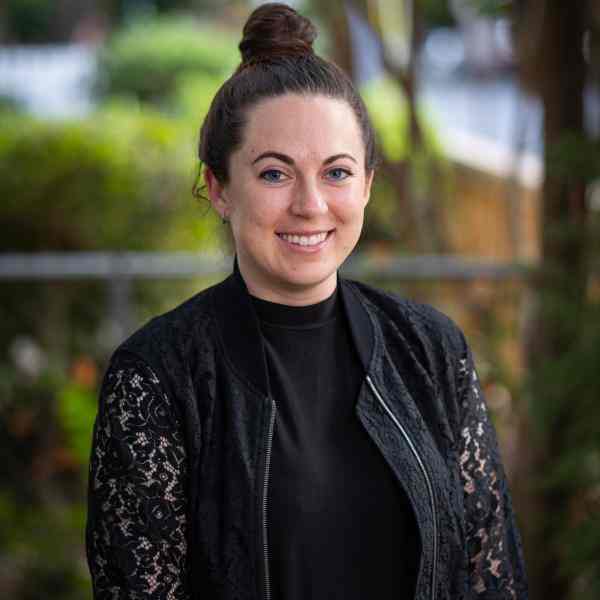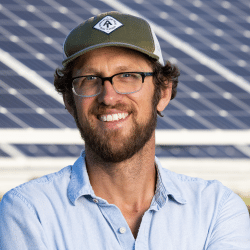Introduction
Through FABSCRAP, Jessica Schreiber is ushering in transformative changes at the intersection of the waste and apparel sectors. She’s simultaneously building a new model and infrastructure for managing textile waste at scale while “hooking” designers and the next generation of fashion’s decision-makers to weave an ethos of sustainability throughout their full design cycle.
The New Idea
Creating new fabric – whether from plants, animals, or petroleum - is an environmentally intense process. That – paired with the industry’s dependency on consumers buying ever more of the latest trends – gives the apparel industry the dubious distinction of being one of the world’s greatest polluters. And to date, most of that waste has been largely invisible. Much of it accrues across the industry’s complex and global supply chain. And domestically, much attention has been paid to post-consumer waste (and how to donate and possibly re-sell an article of secondhand clothing, for example.) But Jess believes we must focus on the leading fashion brands in global hub cities like New York and L.A.; not only do they make the decisions that have environmental impacts – for better or worse - up and down the supply chain, but locally – from trade shows to cutting rooms and warehouses of unsold merchandise - they produce as much as 40x more textile waste than consumers.
In response to this challenge, Jess launched FABSCRAP to change the way people think about fabric waste while building infrastructure to redirect increasing quantities of it away from the landfill. Focusing on the biggest producers of domestic textile waste, today she works with 330 of New York’s 900 leading fashion and apparel brands (and is expanding to L.A.). Clients large and small pay FABSCRAP to collect their textile waste, which is then sorted at central facilities for reuse or recycling at scale. Businesses receive reports that can help make changes upstream to ensure that even more of their byproduct can be reused or recycled (by, for example, avoiding synthetic fibers, which never break down entirely). At the same time, FABSCRAP is also doing the pre-requisite work of sorting and supplying consistent streams of content for emerging innovations like “fiber-to-fiber” recycling.
Over the last two years, Jess and her team have engaged more than 3,500 makers, designers, students, and industry decision-makers in the hands-on work of managing this enormous but previously hard-to-wrap-your-head-around industrial waste stream (and she has an issued patent for a mechanized system, too). Ultimately, she is shifting the mindsets of the next generation of fashion designers and executives – who have an outsized influence on making decisions that affect production as well as hundreds of thousands of consumers - and upending the culture of complacency around textile waste. When Jess is through, the apparel industry will have access to a recycling pipeline similar to what exists now for glass, plastic, and aluminum as well as a deeper commitment to sustainability across the full lifespan of their products.
The Problem
Four hundred million pounds of post-consumer fabric waste is thrown out annually in New York City alone. However, pre-consumer waste - materials discarded by companies and manufacturers during the design of their product - is estimated to be at least 40 times that. In the face of increasing resource scarcity, water scarcity, and climate disruptions, the apparel industry can’t afford to be this wasteful, especially considering its current status as the number two largest global polluter, second only to oil (according to Forbes). This dubious distinction is thanks to that fact that, whether the fibers in textiles came from a plant, an animal, or from crude oil, the intensive processes and complex supply chains that transform them into the clothes on your back, according to ABC News, “are almost always energy- and pollutant-intensive.” A 2018 industry report entitled Measuring Fashion pointed out that “apparel and footwear industries currently account for 8 per cent of global greenhouse gas emissions, nearly as much as that of the whole European Union.” For too long the apparel industry hasn’t been held accountable for its environmental impacts. Rather, it actually adds to them by creating single-use products with short lifespans.
Jess knows one part of the problem well: there is no widespread infrastructure for recycling textile waste. Small amounts can sometimes be donated, and existing recycling operations can take very large, uniform amounts, but for the majority in the middle, landfilling or incineration of waste are the only options. Textile waste is not as easy to recycle as things like cardboard and aluminum cans, nor does it get as much attention as hazardous waste like paint and electronics. Because electronic waste – which accounts for just 1% of the post-consumer waste stream – is categorized as hazardous waste it is heavily regulated and, though the specifics vary from state to state, companies are generally held responsible for providing recycling or waste options in the same volume of product they produce. Because of these “Extended Producer Responsibility” policies, the whole production cycle integrates a set of decisions around the “end-of-life” of each product, from what materials it’s made of to how long a user will be expected to use it.
When it comes to textile waste, the responsibility to reuse, recycle, or throw away has been pushed to the consumer, and meaningful options to do anything other than toss it away or to “donate” are limited (especially since, as Newsweek has reported, 84% of donated clothes ends up in the landfill anyway). Thanks to Waste Characterization Studies conducted by municipal waste and sanitation departments, we know that roughly 6% of the post-consumer waste stream is made up of discarded textiles and garments, and Kate Black, an author focusing on ethical fashion, figures that this leaves the taxpayers of New York shouldering an annual $55M bill to manage textiles in landfills. Neither businesses themselves nor their commercial waste carters are required to track or report on the volume or contents of their waste.
It’s in part because of this very absence of data on the waste profile of upstream actors that calls for changes in the apparel industry have often focused on consumers, and whether to donate clothes, to buy secondhand, or to resist the temptation of “fast fashion”. But Jessica believes these approaches amount to “too little, too late.” Taking a systems-approach, she believes that we must influence the designers, brand managers, and business owners, many of whom are themselves unaware of the amount of waste in their industry, or of the kind of positive, redemptive role that they might be able to play.
The Strategy
One of the most effective ways to reduce the environmental footprint of the textile and apparel industry is to extend the life of the products produced. But interventions that call on consumers to buy differently, slow their consumption, extend the life of their possessions, or donate them fail to address the fact that long-lasting clothes or recycling options are hard to come by. Therefore, Jess is working at the intersection of design and waste to address earlier, systemic challenges. This is because, according to Jessica, “whether or not a product can be recycled at the end of its life is a design decision.” But because this has not become “an internalized cost for the business, consumers purchase the product and pay for disposal,” essentially meaning that businesses are off the hook and consumers are “subsidizing the business’s ability to be wasteful.”
Having started her career at the Department of Sanitation of New York, Jess can empathize with businesses, as she knows that it is already quite hard to do anything other than throw away or incinerate scraps or unused product. An arts-based non-profit may be able to take some left-over material off your hands, or – if your company has the ability to store thousands of pounds of clean fabric – it’s possible to sell to a shredder. But for most shops, the mix of textile waste is very diverse, and to recycle textiles would require sorting by type, removing glue and zippers and the like, and separating proprietary or branded product at scale, which is prohibitively expensive for the individual businesses and has never been done before across the sector. So in 2016, Jess launched FABSCRAP with her own meager savings and support from a panel of celebrity judges from the TV show Project Runway Fashion Startup (on Lifetime) to take on this challenge.
Since then, FABSCRAP’s goal has been to make it as convenient as possible for companies to responsibly manage their unwanted material. Client companies pay a subscription, and then fill black FABSCRAP bags with proprietary product and brown bags with everything else. Clients are required to pay to have the bags taken away, which often requires a “re-verbing”, shifting the industry’s mindset away from “donating” and to “recycling”, thus forcing them to look at this waste stream for what it is. When the 50-pound bags are full, they are picked up and taken to FABSCRAP’s warehouse for sorting. To date, after sorting by fiber type and removing stickers, staples, and the like, about60% of the material that FABSCRAP receives is suitable for reuse. This material, which includes fabric greater than one yard as well as pieces of spandex, leather, trims, and yarns, is sold at the warehouse’s shop, online, and through pop-up shops at regional design schools. Students receive a discount, and free material is provided to other nonprofits, teachers, charitable projects, and to all the volunteers who help with the sorting. Proprietary materials and any fabric less than one yard is shredded and “downcycled” into “shoddy”, a fiber blend that is used in insulation, carpet padding, mattress stuffing, and moving blankets. (While there’s a silver lining to all this hand-sorting – which we’ll discuss three paragraphs down – Jess does have a patent pending on a tool that mechanizes much of this work, offering the promise of working at a greater scale.)
FABSCRAP provides data to their client companies on the weight of material that they disposed of, the percentage FABSCRAP was able to help them reuse, the percentage recycled, and the percentage that was landfilled, if any. Also included in these reports is the state of recycling options for various materials and fibers (which has educational value and, across companies, can trigger even more upstream impacts by influencing more sustainable sourcing, of 100% natural blends, for example). One emerging technology and growing recycling option is “fiber-to-fiber”, where natural fibers can be broken down, blended, and re-spun as new thread. Innovators in this space have, however, struggled when it comes to tapping into consistent and significant streams of uniform content (i.e. 100% cotton), another challenge that FABSCRAP is of course solving.
To date, Jess and her team of four full time employees work with 330 of the 900 designers and brands headquartered in New York City, including small solopreneurs as well as high-end labels like Oscar de la Renta and Marc Jacobs and global mass-market brands like Eileen Fischer, J. Crew, and Express. And in 2020, they are expanding to Los Angeles, the US’s west coast fashion and apparel industry hub.
Another key element of Jess’s overall strategy is HOW she carries out this work for company clients. Over the last 2 years, Jess has engaged more than 3,500 artisans, designers, students, makers, environmentalists, and textile enthusiasts as volunteers at the facility that sorts textiles, as well as teams of key decision makers from their client companies. This is all part of Jess’s longer-term strategy. Rather than chase far-flung and fickle consumers, according to Margaret Bishop, a contributor to Apparel Magazine and a professor at FIT and Parsons, Jess knows that “one brand manager will ultimately influence the shopping habits of tens to hundreds of thousands of shoppers, just by making decisions about the number of styles, quality of styles, and the marketing messages. They are going to have a much greater reach and influence [than even a thousand enlightened consumers].”
Professor Bishop, who has authored two case studies about FABSCRAP to be published in the academic and industry journal Bloomsbury, has noted that current incoming design students and future fashion industry leaders already tend to have a strong desire to do work that is environmentally sustainable, if not beneficial. But she’s quick to point out that many lack a full awareness of the problem, access to systemic solutions, or an understanding of themselves as changemakers. Enter FABSCRAP, which, whether directly or indirectly (in person or via case studies), is becoming present in classrooms across the country. In this way, Jess is able to engage “textile design majors, business majors, [and] fashion students, and all at the point where they are most impressionable, and haven’t yet been told that they can’t do this, that it costs too much, that other factors are more important. When they are most ready to be impressed upon, she gets to these future designers, and future industry leaders.”
The Person
Jessica grew up in rural New Mexico. Though her parents instilled in her a love for nature and the natural world (in part through visits to more than 30 National Parks), they were not environmentalists, nor did they recycle. Instead, Jess remembers using Styrofoam plates daily and taking a weekly trip to the county dump to pay to toss their trash in the landfill.
It was only in college that she discovered recycling and she quickly became obsessed with it, in part because of her familial familiarly with the alternative. Jess’s introduction to recycling coincided with “a growing interest in ecology, environmental science, geology, evolution, and natural history.” By her senior year she was coordinating recycling programs for her university’s dorms and tweaking the incentives that inspired the most lasting behavior changes.
With her initial plans to study medicine thoroughly abandoned, Jess landed her first job after college at the Department of Sanitation of New York (DSNY) and tackled her first project: a Waste Characterization Study, which is a fancy way of saying she literally dug through samples of NYC garbage and recycling and sorted it into 180 different categories to then codify and analyze post-consumer waste patterns. She was in heaven. Not only did she get an intimate introduction to New York and its residents, but her eyes were opened to definitions of “waste”, systems of data management, and strategies for systems thinking and planning. In tackling the surprisingly high percentage of textile waste in the waste stream and in responding to apparel industry representatives’ interest in more sustainable disposal options, Jess convened a yearlong working group of folks across the industry. While she found that DSNY would not be able to meet their specific needs immediately, she began to see how something like FABSCRAP could, and in 2016 she stepped up – and out [of DSNY] - to solve this challenge.




